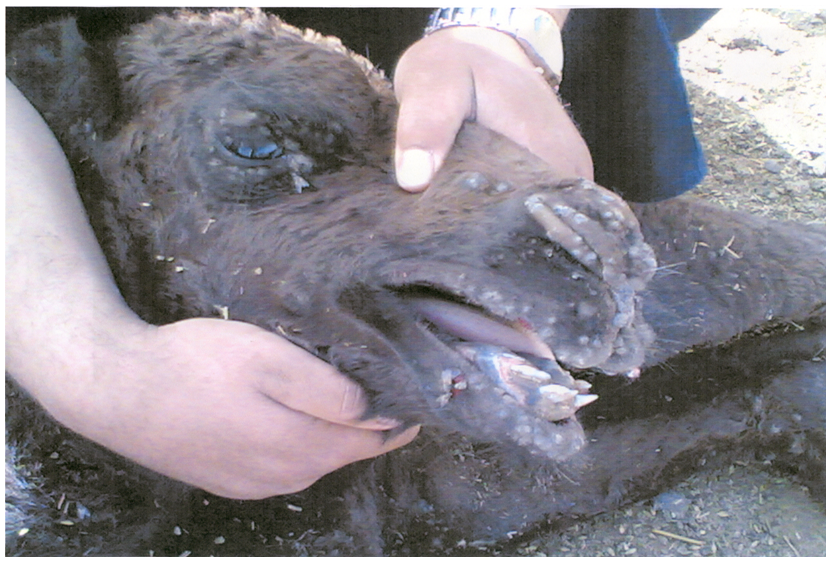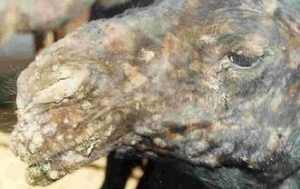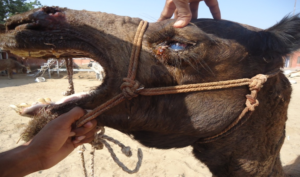Illustrative photo: from open sources
Camel pox is a contagious viral disease characterized by fever, swelling of the head and the appearance of a nodular-pustular rash on the skin and mucous membranes of sick animals, abortions in she-camels and the death of colts. Camels of all ages are susceptible to smallpox, but young animals are more often and more seriously ill. In pregnant camels, smallpox can cause abortions.
According to the literature, significant smallpox outbreaks were observed in the Ural (in 1930, 1942-1943) and Guryev (in 1965-1969) regions of Kazakhstan. The last outbreak of camel pox in Kazakhstan was observed in 1996 in three districts of the Mangistau region. At the same time, only 830 out of 8 thousand camels in the Mangistau region were ill with smallpox, of which 43 died.
Illustrative photo: from open sources
Epizootology. According to Bera et al. in 2009, an outbreak of camel pox in Bikaner province, in Rajasthan district (India), sickened 3 people caring for animals. The main sources of the smallpox virus in camels are sick or ill camels. Infected animals disperse the virus in the external environment with the rejected epithelium of the skin and mucous membranes containing the virus. The virus is also released into the external environment with aborted fetuses. The smallpox pathogen can be spread mechanically by domestic and wild animals that are not susceptible to smallpox.
During the camelpox epizootic, young animals are particularly ill. In the period between epizootics in stationary areas with smallpox, the disease occurs among camels in the form of enzooties and sporadic cases that occur more or less regularly every 3-6 years, mainly among animals aged 2-4 years. In such cases, animals suffer is relatively easy, especially in the warmer time of the year. In cold weather, smallpox is more severe, long-lasting, and is accompanied by complications, especially in young animals.
Method of infection and mechanism of transmission of the pathogen. In natural conditions, healthy camels are infected by contact with sick animals in a virus-contaminated area through infected water, feed, premises and care items, as well as aerogenically by spraying virus-containing effusions with sick animals. More often, camels become infected when the virus enters the body through the skin and mucous membranes, especially when their integrity is violated or when avitaminosis A occurs.
Course and clinical manifestation of smallpox symptoms in camels. The incubation period, depending on the age of camels, the properties of the virus and the ways it enters the body, ranges from 3 to 15 days: in young animals 4-7, in adults 6-15 days. Colts brooded from non-immune she-camels may become ill 2-5 days after birth.
The course of smallpox in camels, depending on their age, is also different: in young animals, especially in a newborn, it is often acute (up to 9 days); in adults, it is subacute and chronic, sometimes latent, more often in pregnant camels. The most characteristic form of smallpox in camels is cutaneous with a subacute course of the disease.
In the subacute course of the disease, a transparent and later a cloudy grayish-dirty color mucus is released from the mouth and nose. Animals shake their heads, sniff and snort, throwing out together with the virus-containing mucus and the virus-affected epithelium. Soon, puffiness forms in the area of the lips, nostrils, and eyelids, sometimes spreading to the infra-temporal area, the neck, and even the sub-chest area. The mandibular lymph nodes and lower neck lymph nodes are enlarged. The animals ‘ appetite decreases, they lie down more often and for longer than usual, and with great difficulty they get up. By this time, reddish-gray spots appear on the skin of the lips, nose and eyelids, on the mucous membrane of the mouth and nose; under them, dense nodules are formed, which, increasing, turn into gray papules, and then into pustules with the size of a pea and a bean with a sinking center and a roller-like thickening at the edges.
Pockpits in sick camels often appear first on the head. At the age from one to four years, camels are usually easily ill. Lesions are localized on the scalp, mainly in the area of the lips and nose. In she-camels, the udder is often affected. A few days after breaking the primary pustules in the head area, smallpox lesions are formed on the skin and other short-haired areas of the body (in the areas of the underbelly, armpits, perineum and scrotum, the inner part of the forearm and thigh), and in she-camels also on the vaginal mucosa. At this time, body temperature of camels usually increase again, sometimes up to 41.5 °C, and she-camels in the last month of pregnancy bring premature and underdeveloped colts, which, as a rule, soon die.
Illustrative photo: from open sources
In some animals, the cornea of the eyes becomes cloudy (a cataract), which causes temporary blindness in one eye for 5-10 days, and in colts, more often in both eyes. Colts that get sick soon after birth have diarrhea. In this case, they die within 3-9 days after the disease.
Illustrative photo: from open sources
The diagnosis of smallpox in camels is based on epizootological data, characteristic symptoms of the disease, pathoanatomic changes, positive results of microscopy (when processing smears and fresh papules using the Morozov silvering method) or electron microscopy and laboratory tests: bioprobes, RDP, ELISA and PCR.
Smallpox in camels must be differentiated from necrobacillosis by microscopic examination of material taken from sick and fallen camels, as well as by experimental infection of white mice susceptible to necrobacillosis. To exclude foot-and-mouth disease, Guinea pigs are infected in the plantar surface of the skin of the paws. Fungal lesions and scabies are excluded by microscopic examination of scrapes taken from the affected areas of the skin. In cases of abortions, miscarriages, and premature foetuses (for exclusion of brucellosis), the blood serum of sick she-camels is tested for brucellosis (RA, RSC, and bacteriological). It is also necessary to exclude the smallpox-like disease Auyzdyk, which is accompanied by a mass disease of young camels, characterized by lesions in the area of the head (lips, nose), by electron microscopy.
Prophylaxis. The only method of protesction in the camel pox is vaccination. Live and inactivated vaccines have been developed worldwide to prevent smallpox in camels. Reports of the existence of a smallpox vaccine for camels first appeared in the Soviet Union.
According to the International epizootic Bureau (OIE, 2008), attenuated and inactivated vaccines are commercially available. Vaccination with live attenuated vaccine provides protection for more than 12 months and with inactivated vaccine for up to 12 months with revaccination.
Camelpox vaccine was also developed at the RSE “Research Institute for biological safety problems”, which was tested in the Mangystau region.
General anti-epizootic measures. In our republic the anti-epizootic measures are carried out in accordance with the veterinary rules “Sanitary-epidemiological and veterinary-sanitary Rules for the prevention and control of infectious diseases common to animals and humans”.
Conclusion. Control of camel pox consists in carrying out veterinary and sanitary measures, explanatory works on compliance with the rules for keeping livestock, and on the procedure for performing their duties provided for by veterinary legislation.
For consultation, call RSE “Research Institute for Biological Safety Problems” SC MES RK by phone (726-36) 7-22-28,
e-mail: ribsp@biosafety.kz
For consultation, call Mambetaliyev Muratbay Aldibayevich, candidate of veterinary sciences, associate professor, tel.+7(775)-772-03-77
For consultation, call Zhugunissov Kuandyk Dauletbaevich, candidate of biological sciences, tel.+7(702)-186-42-73
Regarding the acquisition of the vaccine, call Yershebulov Zakir Dzhaparovich, Head of the Quality Department, tel.+7(778)-881-46-83






